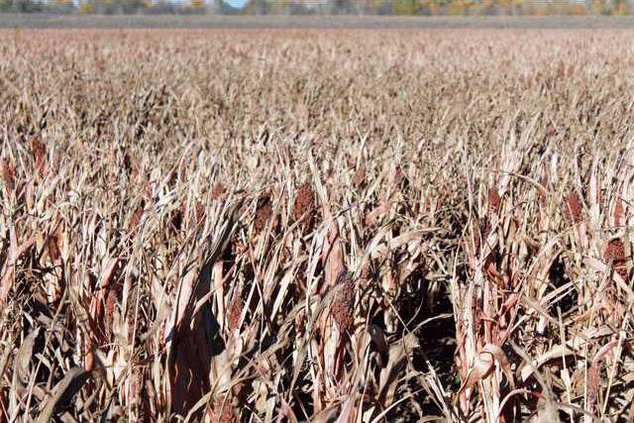Rosie Meir, grain accountant at Great Bend Co-op sums up the outlook for the 2012 milo crop with one word.
Bleak.
After making a “very conservative” predicition earlier that this year’s harvest would yield 700,000 bushels, she doesn’t think they’ll hit the mark.
“We predicted we’d get 2.5 million bushels of corn, 600,000 beans, and 700,000 milo,” Meirs said. “We ended up with 2.9 million corn, 760,000 beans, but so far we’ve only seen 300,000 bushels of milo, and we’re probably 60 percent done.”
Dryland milo has been harvested, and irrigated is coming in slowly, depending on weather.
According to Meir, milo is one of the more drought resistant crops suited to the area, and most is planted in April and May, with a second harvest planted in June. This year, some farmers were able to plant a few weeks earlier than normal due to mild spring conditions, and were able to get crops germinated before the moisture dried up.
As farmers finished up the 2012 wheat harvest, some questioned whether they would plant a rotation of milo, as the mercury continued to climb with nothing but blue skies in the forecast. One encouraging downpour offered a little hope, but didn’t add enough subsoil moisture to make much of a difference. Without proper subsoil moisture, milo won’t send up a head, the part that holds the grain.
“It doesn’t need a lot of moisture, but it does need some,” Meier said.
Some years, the harvest has been so bountiful, milo was stored on the ground in beautiful, multi-colored piles of red, pink and gold, but this year, the Great Bend elevator has plenty of room. Two markets are directly affected by these poor yeilds--cattle feed and ethanol. Since the Great Bend Co-op runs its own feed mill, Meier doesn’t expect much will be leaving their facility. Each year, they go through about 200,000 bushels, she said. Overall, however, cattle producers can substitue milo with several other grains, and will likely spend their money on what makes the most financial sense. Ethanol plants have already announced plans to cut production due to rising costs for grain due to the drought.
Wheat
This fall the Co-op has sold and treated form seed wheat than they have in years past, Meier said. This may be in anticipation of another dry year.
“If we don’t get much for moisture this winter, farmers may be harvesting wheat and not going back to plant corn and beans,” she said. Most finished planting prior to the Oct. 6 rain, but some are still finishing up in order to lock in their price with crop insurance companies for next year.
Crops need to be planted and certified to be eligible for crop insurance. They are insured at the level chosen by the farmer. Taxpayers in recent years have picked up more of the cost of these crop insurance premiums, and have paid out more reimbursements to crop insurance companies.
Less milo, more wheat





